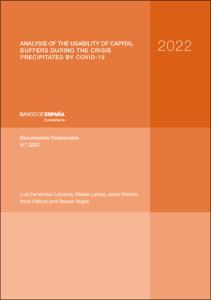Analysis of the usability of capital buffers during the crisis precipitated by COVID-19
Autor
Fecha de publicación
15-nov-2022
Descripción física
33 p.
Resumen
Este trabajo analiza la capacidad de uso de los colchones de capital voluntarios y regulatorios por parte de las entidades bancarias, aprovechando la experiencia de la pandemia de COVID-19. En primer lugar, se encuentra que la usabilidad de los colchones macroprudenciales está muy poco limitada en España por otros requerimientos sobre las entidades. Adicionalmente, se encuentra que los colchones existentes sobre los requerimientos de capital al comienzo de la pandemia han tenido efectos significativos en los mercados financieros, lo que ha afectado a la evolución de las cotizaciones bancarias europeas, así como a las tenencias de acciones bancarias por parte de los fondos de inversión. Por último, no se observa un efecto agregado significativo del nivel disponible de colchones de capital sobre los requerimientos de capital en la provisión de financiación a las empresas no financieras en España. Sin embargo, sí se identifican efectos negativos en la oferta de crédito de los bancos con menores colchones voluntarios a las empresas con las que tenían relaciones más recientes. Asimismo, cuando el análisis se realiza exclusivamente sobre las operaciones crediticias sin garantía pública, sí se observa que las entidades con menor margen de capital por encima de los requerimientos redujeron más el crédito.
This paper analyses the ability of banks to use voluntary and regulatory capital buffers, taking advantage of the experience of the COVID-19 pandemic. In the first place, we find that the usability of macroprudential buffers is not hampered in Spain by other parallel banks’ requirements. Additionally, we find that the existing voluntary buffers over capital requirements at the beginning of the pandemic have had significant effects on the financial markets, affecting the evolution of European bank stock prices, as well as the holdings of bank shares by investment funds. Lastly, we find no significant aggregate effect of voluntary capital buffers on the provision of financing to non-financial companies in Spain. However, we do identify negative effects in the supply of credit from banks with lower voluntary buffers to companies with which they had more recent relationships. Likewise, if the analysis is carried out exclusively on credit operations without public guarantees, we observe that those banks with lower voluntary capital buffers reduced credit more.
This paper analyses the ability of banks to use voluntary and regulatory capital buffers, taking advantage of the experience of the COVID-19 pandemic. In the first place, we find that the usability of macroprudential buffers is not hampered in Spain by other parallel banks’ requirements. Additionally, we find that the existing voluntary buffers over capital requirements at the beginning of the pandemic have had significant effects on the financial markets, affecting the evolution of European bank stock prices, as well as the holdings of bank shares by investment funds. Lastly, we find no significant aggregate effect of voluntary capital buffers on the provision of financing to non-financial companies in Spain. However, we do identify negative effects in the supply of credit from banks with lower voluntary buffers to companies with which they had more recent relationships. Likewise, if the analysis is carried out exclusively on credit operations without public guarantees, we observe that those banks with lower voluntary capital buffers reduced credit more.
Publicado en
Documentos Ocasionales / Banco de España, 2223
Otras versiones
Materias
Usabilidad del capital; Margen de capital voluntario; Cotizaciones bancarias; Provisión de crédito; Capital usability; Voluntary capital buffers; Bank stock prices; Provision of credit; Regulación y supervisión de instituciones financieras; Instituciones crediticias de depósito; España
Aparece en las colecciones:












